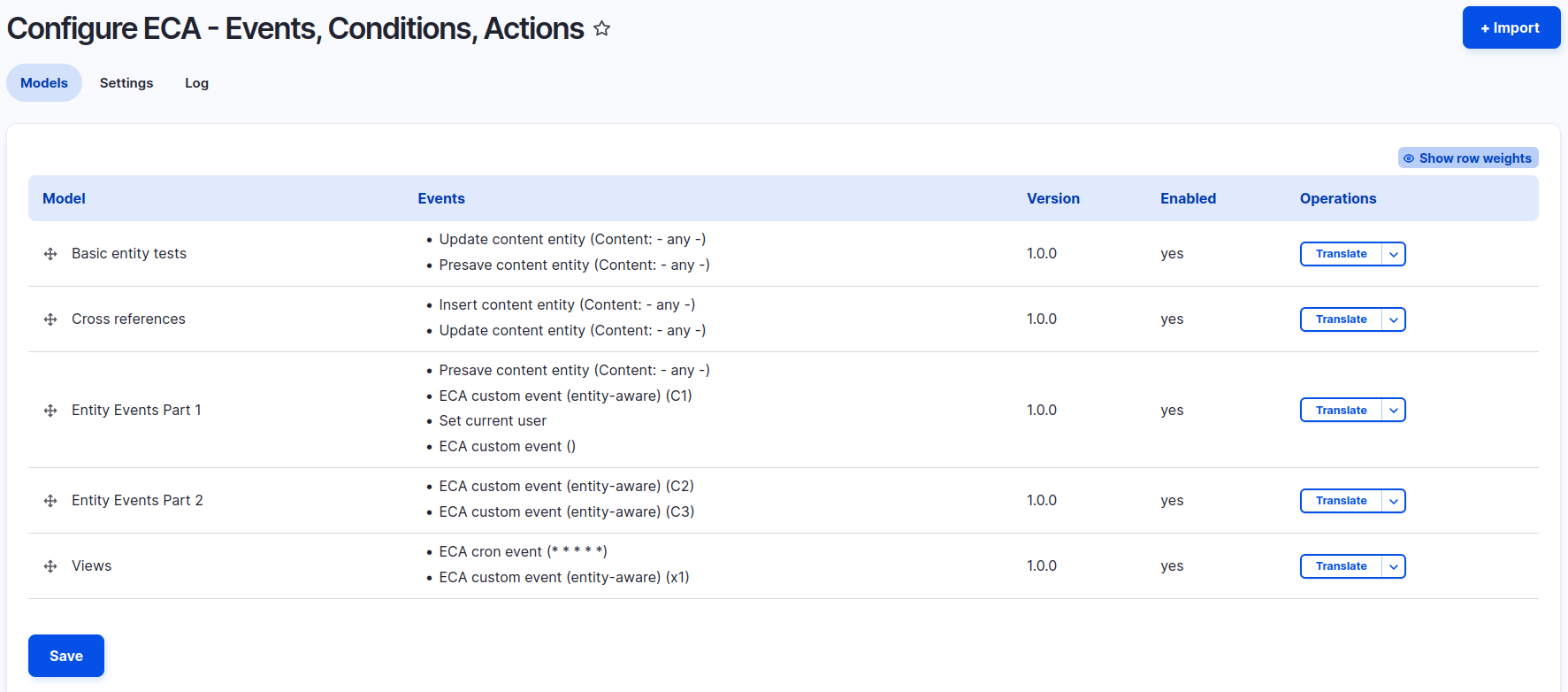Using the ECA module¶
Once installed and configured, the Events - Conditions - Actions (ECA) module operates automatically in the background. This page explains how ECA processes models and how to manage them on your site.
How ECA works¶
ECA monitors Drupal events and executes defined models when those events occur. When the models are in place, and enabled, they run without any user interaction. In fact, there is nothing that a user can do to prevent ECA from processing the enabled modules.
Attention
It may occur that your site stops functioning because of an ECA model. If you experience this, or any issue affecting your site functionality, refer to the troubleshooting guide for solutions.
Background processing¶
ECA continuously processes all enabled models. The module:
- Listens for events occurring on your Drupal site
- Matches events to conditions defined in your models
- Executes the appropriate actions when conditions are met
Optionally disabling the ECA admin UI on production environments¶
ECA doesn't require the ECA UI module (eca_ui) in order to function.
Some Drupal administrators may choose to turn off the UI and the modeler in production environments.
The steps are as follows:
- Create and test ECA models in your development environment
- Export the models to your production site
- Enable only ECA and required submodules on production
- Uninstall the
eca_uimodule on production
Drupal takes a similar approach for Views and Fields - the user interfaces for those modules can also be (optionally) disabled.
ECA admin UI is separate from the modeler¶
The ECA admin UI does not, by itself, provide you access to create or edit models.
To make the BPMN.iO modeler interface available, go to Administration > Extend (/admin/modules)
and enable thie BPMN.iO for ECA module.
If you are familiar with the command-line, you can use drush:
1 | |
Site performance¶
ECA dynamically subscribes to all Drupal events which have been defined in the active models on your site. The module uses cached information to quickly determine whether an event is relevant to any configured models, avoiding unnecessary processing overhead. In fact, in our own tests, we have not seen any measurable performance impact, over and above that of the Symfony event dispatching in Drupal.
ECA model configuration¶
Each ECA model consists of two configuration entities:
eca.eca.[MODEL-ID]- Contains the events, conditions, and actionseca.model.[MODEL-ID]- Contains the modeler-specific data
The first entity (eca.eca.[MODEL-ID]) is what ECA uses to operate on your site.
The second entity is only required when editing the model.
When you save a model using a modeler, ECA recreates the first entity by converting the modeler data.
Always keep both configuration entities together, as ECA keeps them synchronized.
Never edit the .yml files manually, as the eca.eca entity is always regenerated from the eca.model entity.
Note
Since the release of ECA version 2.1, you can (optionally) omit the eca.model.[MODEL-ID] configuration entity.
Administrative interface¶
The ECA administrative interface is optional and can be enabled separately:
1 | |
After enabling the UI, access it at Administration > Configuration > Workflow > ECA,
or at the path /admin/config/workflow/eca.

Models tab¶
The Models tab allows you to:
- Reorder models to change their processing sequence
- Enable or disable models: disabled models are not processed by ECA
- Delete an ECA model entirely from the Drupal site
- Clone an ECA model with a new random model ID
- Export an ECA model
- Export an ECA model as a Drupal Recipe
If the bpmn_io module is enabled, you can edit the model in the modeler interface.
Import tab¶
The Import tab (/admin/config/workflow/eca/import) allow you to import a model from an archive tar.gz file.
The archive has the name format [MODELLER-TYPE]-[MODEL-ID].tar.gz.
This could be an archive you have exported previously, or one of the many examples which you can download from the ECA Library.
Settings tab¶
The Settings tab (/admin/config/workflow/eca/settings) provides these configuration options:
Log level¶
Controls which ECA messages are recorded in your site's logging system. The default setting logs only errors, but you can increase verbosity for debugging purposes. For detailed logging, see the debugging guide.
Documentation domain¶
Determines where documentation links point when using a modeler. The default is https://ecaguide.org, but you can change this to your own documentation site, or leave it empty to disable documentation links.
Execute models with user¶
Allows you to specify the User ID (uid) of the user account that ECA uses to execute models.
It is recommended to leave this field empty unless you have a good reason to set another user account.
By default, the current user's account is used to execute models, that works for most use cases.
Service account user¶
The service account is a Drupal user account ECA will switch to when the action "Switch to service user" is executed in a model.
Logs tab¶
When the Database Logging (dblog) module is enabled, you can view ECA log messages through the Logs tab:
admin/config/workflow/eca/log.
The log displays messages according to the log level you have configured in the Settings tab.
Log entries can be filtered by content or time range.